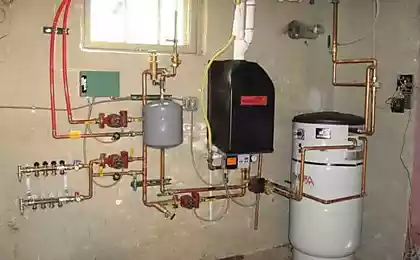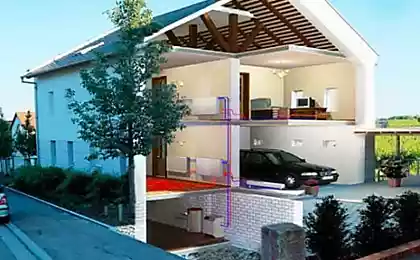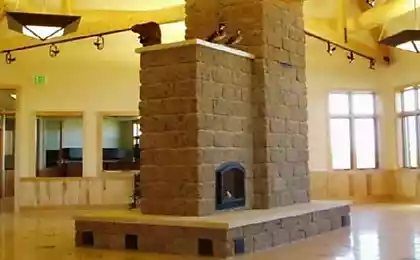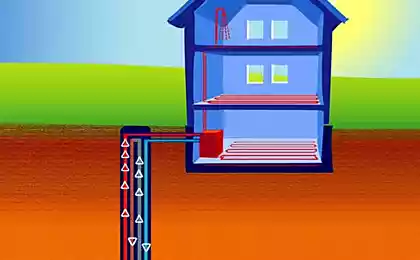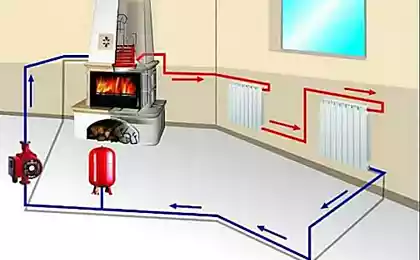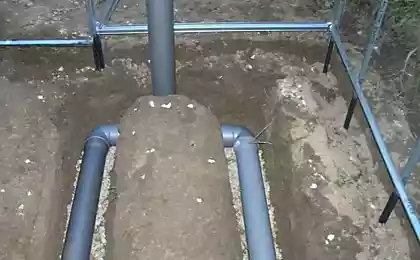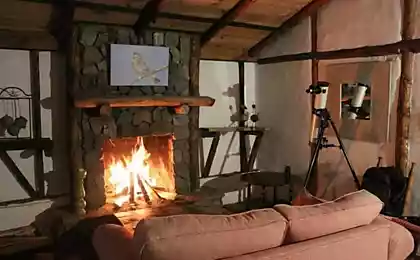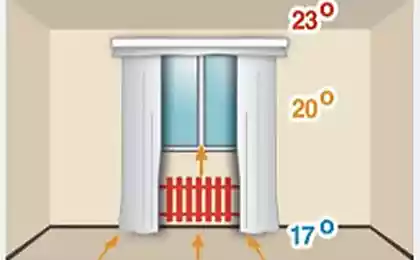489
About ceiling mounted radiant panels
We all know the pleasant feeling of warmth from the sun when in the street minus temperature. I want to experience again and again, thinking about summer and hot weather. Being outside on a cold day, with temperatures below 20 degrees, you "bask" in the sunlight... Although some warming themselves around – — 20! What then can be said about sunbathing, holidaymakers take in some swimsuits in the Alps when the thermometer shows a temperature below zero? Despite the fact that these people are not "walrus", and the most common, unhardened people?
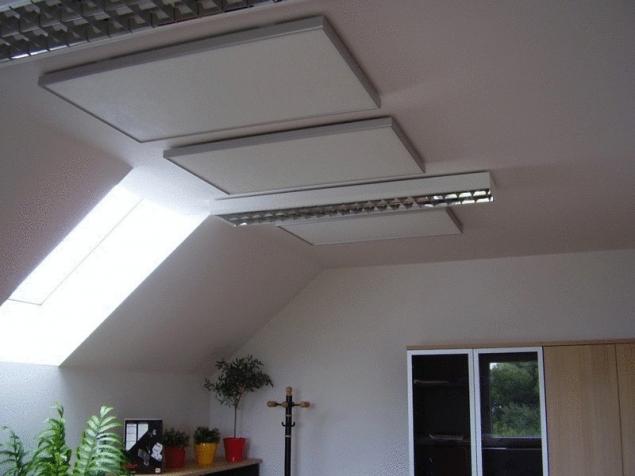
Just as the sun in the cold, "work" infrared heaters, which we describe next. Heat rays that are sent to them, absorb and then share with us a variety of surfaces (furniture, floors., walls, etc.). Some of you may say: "Yes, I am aware of domestic and industrial infrared heating systems, powered by gas or electricity. Finding them is easy, they are sold in many shops and markets".
But as for the ceiling mounted radiant panels, which work well together with a heat pump increasing its efficiency, you have to hear, most likely, was not necessary.
It is this equipment and will be discussed in this article.
Solar radiant heat
What is an infrared heater? Here it is useful to recall some elementary concepts.
All heated bodies share warmth with the objects around, using 3 methods:
— thermal radiation (the infrared electromagnetic radiation emitted by the body);
— convection (transfer of heat via gas/liquid to flow around the heated object and thus warm other items);
— heat conduction (exchange of heat between objects through the interface between them).
Actually, the infrared emitter can be called any heated object, which shares the warmth by using radiation and other means of heat transfer from him with almost no result.
Consider the example of an ordinary heating radiator. If the device is located on the wall, it gives off heat by two methods, radiation and convection, or heating of the air, which it wraps around (twenty and eighty percent, respectively).
If this heater to place under the ceiling, the convection will be minimal effect on the foreground there will be radiation. To make it more powerful, behind the radiator you can place the reflector. As a result, we get a device that represents the IR-heater.
About infrared rays
Infrared rays are electromagnetic radiation, are subject to the laws of optics, which means that they have the same nature as the light that we can see. These rays are in the spectrum between "normal" and red light. Their sources are all liquid or solid heated body. As for the length of the emitted wave, it is determined by the temperature of the subject. At a higher temperature, the waves have a shorter length, in this case, the radiation is more intense.
By the way, at low temperatures a solid body emits only infrared light, because it seems dark. When the temperature increases, the waves become visible, because first we see the dark red subject, then red, then yellow, and at high temperature it is "white".
Why do you need this information? In the first place, in order that you are not confused in terms. Some manufacturers assure that the supplied heaters – infrared, others that they are light, others dark, the fourth write about far devices.
But they are all infrared, just data devices emit waves of different lengths (1 – 20 µm). Emitting surface long-wave infrared device has a low temperature, and it emitted the longest waves. One of their name – dark. The working surface t, the component of 300-400 degrees Celsius is the reason that these heaters do not emit visible light. Light/white fixtures that emit short wave, t heat up to 800 degrees or more.
The properties of infrared radiation
Optical quality substances, such as refractive index, reflectance, transparency, in the infrared spectral region usually have significant differences from similar qualities in the area that we can see. So, for example, a water layer, the thickness of which is several cm, cannot overcome the 1-micrometer (or more) infrared radiation. That is why water is very often used as a filter protecting from heat. A silicon wafer, which seem to be opaque, transparent in the IR spectral region.
Many metals better reflect infrared radiation than that which is visible to our eyes. Moreover, the longer wave IR light, the more reflective they have. So, the reflection coefficient of copper, gold, aluminum and silver, while the 10-µm wavelength is equal to ninety-eight percent. Materials for infrared transparent, or reflecting the infrared rays used in the manufacture of infrared devices. "Transparent" play the role of filters (usually it is a quartz), which are used as reflectors, through which the radiation is directed in the desired direction, either of them do emitting surface (most often is aluminum).
The air is "moving" of the infrared radiation does not interfere. Molecules of gases such as oxygen and nitrogen, infrared radiation does not absorb, they only slightly weaken.
How does the "infrared" heating (infrared, radiant heating)
We already know that heat radiation of the heater radiating infrared light, air does not absorb. Because the energy from the device "delivered" to people and objects almost in full, and in this heat not the air (like heaters), namely, people and objects. That is, the ceiling panels radiant heating transfer heat to solid objects such as furniture, walls, etc., which then give it air. Of course, in close proximity to the device bodies and the density of the heat flow is higher. In addition, these devices emit heat only in the area of his direct action.
The advantages of the use of ceiling mounted radiant panels:
— Radiant heating is characterized by the accumulation of warm air at the top, near the ceiling, as happens with convective heating (in some cases even have "forced" to back down by using desertification fans. or ceiling fans).
That is, the IR system performed in accordance with the saying of the doctors, according to which the head should be cold, and feet warm. Thanks to this feature they become the great option of heating in which very high ceilings, because the design significantly save energy. After all, the greater the room volume, the harder and more expensive to heat – while the top of the room is warm, the working area (bottom) will remain "cold". Indispensable these devices in situations where heat must not the entire room, and a certain area, or when convective air flow and "flying" with them, dust is unacceptable (for people suffering from allergies, this is very important).
— The use of IR heating can reduce the temperature that is created by the main heating system, with no "damage" for sensations staying in the room (they will freeze). This is because a person feels t is the arithmetic average between the average t of the surfaces that are around him and t air. Since the ceiling panels radiant heating heats surfaces which then warm the air at lower temperature the person will not be cold, he will feel the same t as before.
More details about this approach can be learned from building codes, which are used by the experts designing the heating system.
Thus, through the use of such devices decreases the amount of "heating" energy, which saves on heating.
- The ceiling panels does not limit you to the placement of equipment or furniture, they do not take up space in the room, do not save the workspace. Through them without any problems held a variety of engineering network, these panels are embedded lighting
— Using such heating systems, it is possible to solve very complex tasks almost impossible with other equipment.
So, for example, they can protect from the cold that emanates from the large glass window designs, stained glass window and other "gadgets" that let in light. Earlier such structures was heated with a heater, which allowed to prevent the formation of condensate. With ceiling panels need the heaters disappears. Heat rays, which emit a similar heating system, perfectly warm glass, providing protection from the formation of moisture. Because they are effective in rooms with high ceilings and in buildings with lots of Windows (public lobbies, car showrooms, shopping centers). Use of such devices and in suburban homes with wide and large Windows.
They also allow you to save on ventilation. As t of air may be below the put two or three degrees, eliminating the need for heat supply and ventilation air (it can be colder, too, on two-three degrees). Individual objects can save considerable amount of money.
Through such installations (heating/cooling) to the premises may "be delivered" cold, only that it requires the source – the chiller (in summer time – a heat pump). The fact that the system heat can be cold water, is a significant plus in favor of the installation of ceiling mounted radiant panels, as they provide a comfortable indoor temperature throughout the year. Thus, if we apply such a system for "delivery" of the cold, you'll be able to save on the development of this very cold due to the fact that the refrigeration machine is operating along with water panels boasts greater efficiency (by forty percent) is a she in this case is not required to cool the water to standard temperatures.
As you can see, such systems have many advantages. Their use will make the room more comfortable (winter and summer), in addition, they will allow you to save a considerable amount of money.
Source: zeleneet.com

Just as the sun in the cold, "work" infrared heaters, which we describe next. Heat rays that are sent to them, absorb and then share with us a variety of surfaces (furniture, floors., walls, etc.). Some of you may say: "Yes, I am aware of domestic and industrial infrared heating systems, powered by gas or electricity. Finding them is easy, they are sold in many shops and markets".
But as for the ceiling mounted radiant panels, which work well together with a heat pump increasing its efficiency, you have to hear, most likely, was not necessary.
It is this equipment and will be discussed in this article.
Solar radiant heat
What is an infrared heater? Here it is useful to recall some elementary concepts.
All heated bodies share warmth with the objects around, using 3 methods:
— thermal radiation (the infrared electromagnetic radiation emitted by the body);
— convection (transfer of heat via gas/liquid to flow around the heated object and thus warm other items);
— heat conduction (exchange of heat between objects through the interface between them).
Actually, the infrared emitter can be called any heated object, which shares the warmth by using radiation and other means of heat transfer from him with almost no result.
Consider the example of an ordinary heating radiator. If the device is located on the wall, it gives off heat by two methods, radiation and convection, or heating of the air, which it wraps around (twenty and eighty percent, respectively).
If this heater to place under the ceiling, the convection will be minimal effect on the foreground there will be radiation. To make it more powerful, behind the radiator you can place the reflector. As a result, we get a device that represents the IR-heater.
About infrared rays
Infrared rays are electromagnetic radiation, are subject to the laws of optics, which means that they have the same nature as the light that we can see. These rays are in the spectrum between "normal" and red light. Their sources are all liquid or solid heated body. As for the length of the emitted wave, it is determined by the temperature of the subject. At a higher temperature, the waves have a shorter length, in this case, the radiation is more intense.
By the way, at low temperatures a solid body emits only infrared light, because it seems dark. When the temperature increases, the waves become visible, because first we see the dark red subject, then red, then yellow, and at high temperature it is "white".
Why do you need this information? In the first place, in order that you are not confused in terms. Some manufacturers assure that the supplied heaters – infrared, others that they are light, others dark, the fourth write about far devices.
But they are all infrared, just data devices emit waves of different lengths (1 – 20 µm). Emitting surface long-wave infrared device has a low temperature, and it emitted the longest waves. One of their name – dark. The working surface t, the component of 300-400 degrees Celsius is the reason that these heaters do not emit visible light. Light/white fixtures that emit short wave, t heat up to 800 degrees or more.
The properties of infrared radiation
Optical quality substances, such as refractive index, reflectance, transparency, in the infrared spectral region usually have significant differences from similar qualities in the area that we can see. So, for example, a water layer, the thickness of which is several cm, cannot overcome the 1-micrometer (or more) infrared radiation. That is why water is very often used as a filter protecting from heat. A silicon wafer, which seem to be opaque, transparent in the IR spectral region.
Many metals better reflect infrared radiation than that which is visible to our eyes. Moreover, the longer wave IR light, the more reflective they have. So, the reflection coefficient of copper, gold, aluminum and silver, while the 10-µm wavelength is equal to ninety-eight percent. Materials for infrared transparent, or reflecting the infrared rays used in the manufacture of infrared devices. "Transparent" play the role of filters (usually it is a quartz), which are used as reflectors, through which the radiation is directed in the desired direction, either of them do emitting surface (most often is aluminum).
The air is "moving" of the infrared radiation does not interfere. Molecules of gases such as oxygen and nitrogen, infrared radiation does not absorb, they only slightly weaken.
How does the "infrared" heating (infrared, radiant heating)
We already know that heat radiation of the heater radiating infrared light, air does not absorb. Because the energy from the device "delivered" to people and objects almost in full, and in this heat not the air (like heaters), namely, people and objects. That is, the ceiling panels radiant heating transfer heat to solid objects such as furniture, walls, etc., which then give it air. Of course, in close proximity to the device bodies and the density of the heat flow is higher. In addition, these devices emit heat only in the area of his direct action.
The advantages of the use of ceiling mounted radiant panels:
— Radiant heating is characterized by the accumulation of warm air at the top, near the ceiling, as happens with convective heating (in some cases even have "forced" to back down by using desertification fans. or ceiling fans).
That is, the IR system performed in accordance with the saying of the doctors, according to which the head should be cold, and feet warm. Thanks to this feature they become the great option of heating in which very high ceilings, because the design significantly save energy. After all, the greater the room volume, the harder and more expensive to heat – while the top of the room is warm, the working area (bottom) will remain "cold". Indispensable these devices in situations where heat must not the entire room, and a certain area, or when convective air flow and "flying" with them, dust is unacceptable (for people suffering from allergies, this is very important).
— The use of IR heating can reduce the temperature that is created by the main heating system, with no "damage" for sensations staying in the room (they will freeze). This is because a person feels t is the arithmetic average between the average t of the surfaces that are around him and t air. Since the ceiling panels radiant heating heats surfaces which then warm the air at lower temperature the person will not be cold, he will feel the same t as before.
More details about this approach can be learned from building codes, which are used by the experts designing the heating system.
Thus, through the use of such devices decreases the amount of "heating" energy, which saves on heating.
- The ceiling panels does not limit you to the placement of equipment or furniture, they do not take up space in the room, do not save the workspace. Through them without any problems held a variety of engineering network, these panels are embedded lighting
— Using such heating systems, it is possible to solve very complex tasks almost impossible with other equipment.
So, for example, they can protect from the cold that emanates from the large glass window designs, stained glass window and other "gadgets" that let in light. Earlier such structures was heated with a heater, which allowed to prevent the formation of condensate. With ceiling panels need the heaters disappears. Heat rays, which emit a similar heating system, perfectly warm glass, providing protection from the formation of moisture. Because they are effective in rooms with high ceilings and in buildings with lots of Windows (public lobbies, car showrooms, shopping centers). Use of such devices and in suburban homes with wide and large Windows.
They also allow you to save on ventilation. As t of air may be below the put two or three degrees, eliminating the need for heat supply and ventilation air (it can be colder, too, on two-three degrees). Individual objects can save considerable amount of money.
Through such installations (heating/cooling) to the premises may "be delivered" cold, only that it requires the source – the chiller (in summer time – a heat pump). The fact that the system heat can be cold water, is a significant plus in favor of the installation of ceiling mounted radiant panels, as they provide a comfortable indoor temperature throughout the year. Thus, if we apply such a system for "delivery" of the cold, you'll be able to save on the development of this very cold due to the fact that the refrigeration machine is operating along with water panels boasts greater efficiency (by forty percent) is a she in this case is not required to cool the water to standard temperatures.
As you can see, such systems have many advantages. Their use will make the room more comfortable (winter and summer), in addition, they will allow you to save a considerable amount of money.
Source: zeleneet.com

